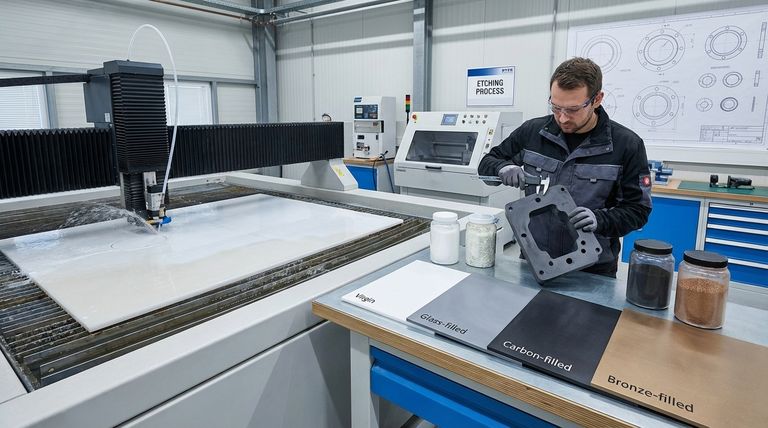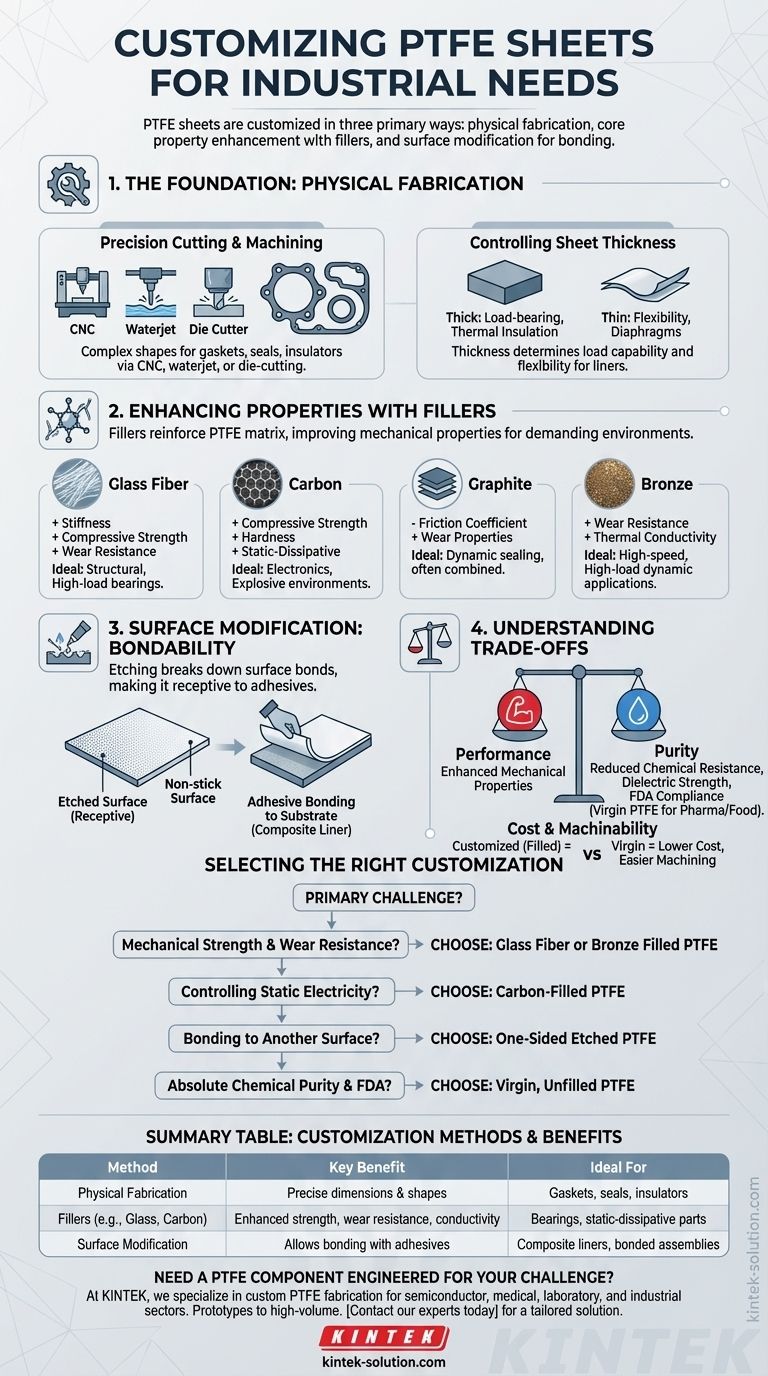In short, Polytetrafluoroethylene (PTFE) sheets are customized in three primary ways. They can be physically fabricated to specific dimensions, their core material properties can be enhanced by adding fillers, and their surfaces can be modified to allow bonding with other materials. This adaptability allows a single polymer to be precisely engineered for countless industrial challenges.
The core takeaway is that while standard "virgin" PTFE is an excellent starting point, it is often too soft or inert for demanding applications. Strategic customization—especially through the addition of reinforcing fillers—is what transforms PTFE from a general-purpose material into a high-performance engineering solution.

The Foundation: Physical Fabrication
The most direct form of customization involves altering the physical shape and size of the PTFE sheet. This is a fundamental requirement for fitting the material into a specific mechanical assembly.
Precision Cutting and Machining
Most industrial uses, such as creating gaskets, seals, or insulating spacers, require PTFE sheets to be cut into precise, often complex shapes. This is achieved through CNC machining, waterjet cutting, or die-cutting to match exact design specifications for components like packings and envelope gaskets.
Controlling Sheet Thickness
The thickness of a PTFE sheet is a critical variable. Thicker sheets provide better load-bearing capability and thermal insulation, while thinner sheets offer greater flexibility for applications like diaphragms or liners that must conform to a surface.
Enhancing Core Properties with Fillers
Virgin PTFE is chemically inert and has an extremely low coefficient of friction, but it is also mechanically soft and prone to deformation ("creep") under load. Adding fillers is the most powerful method for enhancing its mechanical and physical properties.
Why Additives are Necessary
Fillers create a composite material, reinforcing the PTFE matrix to improve specific characteristics. This process addresses the inherent weaknesses of pure PTFE, dramatically expanding its operational range in demanding industrial environments.
Common Fillers and Their Impact
-
Glass Fiber: This is one of the most common fillers. It significantly increases stiffness, compressive strength, and wear resistance. Glass-filled PTFE is ideal for structural components and high-load bearings.
-
Carbon: Adding carbon improves compressive strength, hardness, and load-bearing capabilities. Critically, it also transforms PTFE from an excellent electrical insulator into a static-dissipative material, essential for electronics or explosive environments.
-
Graphite: Often used in combination with other fillers like carbon or glass, graphite reduces the coefficient of friction even further and enhances wear properties, making it perfect for dynamic sealing applications.
-
Bronze: This metallic filler provides excellent wear resistance and high thermal conductivity, allowing heat to dissipate quickly from bearing surfaces. This makes bronze-filled PTFE a top choice for high-speed, high-load dynamic applications.
Advanced Customization: Surface Modification
PTFE's non-stick nature is a benefit in many cases, but a major drawback when it needs to be attached to other materials. Surface modification overcomes this challenge.
Etching for Bondability
One side of a PTFE sheet can be chemically etched. This process breaks down the fluorine-carbon bonds on the surface, making it receptive to adhesives. Etched PTFE is essential for applications where the sheet must be permanently bonded to a metal or rubber substrate to create a composite liner.
Understanding the Trade-offs
Customization is not without compromise. Enhancing one property can often come at the expense of another, and it's crucial to understand these balances.
Performance vs. Purity
Adding fillers dramatically improves mechanical properties but can slightly reduce PTFE's exceptional chemical resistance and dielectric strength. For applications requiring FDA compliance or absolute chemical inertness (like in pharmaceuticals or food processing), virgin, unfilled PTFE remains the only choice.
Cost and Machinability
Customized PTFE, particularly grades with high percentages of fillers, is more expensive than virgin material. Furthermore, fillers like glass and bronze are abrasive and can cause more rapid wear on machine tools during fabrication, which can increase manufacturing costs.
Selecting the Right Customization for Your Application
Choosing the correct PTFE variant requires a clear understanding of the primary challenge you need to solve.
- If your primary focus is mechanical strength and wear resistance: Choose a PTFE sheet filled with glass fiber or bronze.
- If your primary focus is controlling static electricity: Your best option is a carbon-filled PTFE sheet.
- If your primary focus is bonding the PTFE to another surface: You must specify a one-sided etched PTFE sheet.
- If your primary focus is absolute chemical purity and FDA compliance: Use only virgin, unfilled PTFE.
By moving beyond standard sheets and leveraging these customization methods, you can engineer a PTFE solution that precisely meets your application's unique demands.
Summary Table:
| Customization Method | Key Benefit | Ideal For |
|---|---|---|
| Physical Fabrication | Precise dimensions & shapes | Gaskets, seals, insulators |
| Fillers (e.g., Glass, Carbon) | Enhanced strength, wear resistance, conductivity | Bearings, static-dissipative parts |
| Surface Modification | Allows bonding with adhesives | Composite liners, bonded assemblies |
Need a PTFE component engineered for your specific challenge?
At KINTEK, we specialize in custom PTFE fabrication for the semiconductor, medical, laboratory, and industrial sectors. Whether you need prototypes or high-volume orders, our precision manufacturing and material expertise ensure your components meet exact performance requirements—from enhanced mechanical properties with specialized fillers to surface-modified sheets for complex assemblies.
Contact our experts today to discuss your project and receive a tailored solution.
Visual Guide

Related Products
- Custom PTFE Parts Manufacturer for Teflon Parts and PTFE Tweezers
- Custom PTFE Parts Manufacturer for Teflon Containers and Components
- Custom PTFE Sealing Tapes for Industrial and High Tech Applications
- Custom PTFE Sleeves and Hollow Rods for Advanced Applications
- Customizable PTFE Seals Filter Holders for Versatile Applications
People Also Ask
- What factors should be considered when choosing between Nylon and PTFE? Select the Right Material for Your Application
- What chemical processing applications involve PTFE-machined parts? Essential Components for Corrosive & High-Purity Systems
- What are the unique properties of PTFE? The 3 Pillars Driving Demand for High-Performance Parts
- What finishing techniques are effective for machined Teflon parts? Achieve Functional Performance and Dimensional Stability
- What are the main applications of PTFE type Teflon? Unlock Its Versatility for Your Industry



















